High-Efficiency, Dual-Band Beam Splitter Based on an All-Dielectric Quasi-Continuous Metasurface
Abstract
1. Introduction
2. Materials and Methods
3. Results
3.1. The Optical Response of the Quasi-Continuous Metasurface Composed of Antenna I Array
3.2. Influence of the Relative Moving Distance
3.3. The Optical Performance of the Proposed Beam Splitter
4. Discussion
5. Conclusions
Author Contributions
Funding
Institutional Review Board Statement
Informed Consent Statement
Data Availability Statement
Conflicts of Interest
Appendix A. Design of the Trapezoidal Antenna I
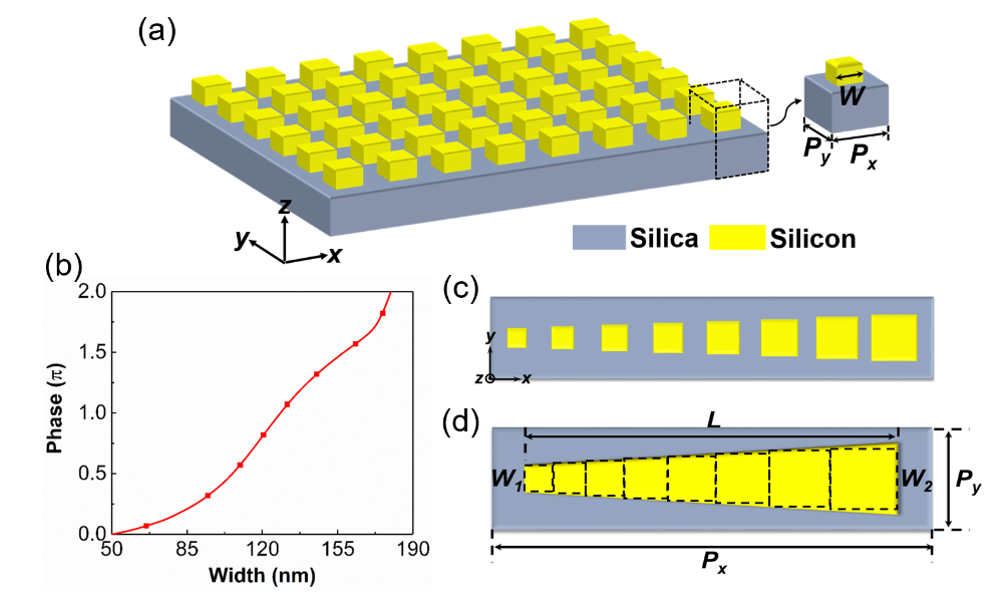
Appendix B. Unequal-Power Beam-Splitting Performance of Antenna I Array Under x-Polarized Incidence
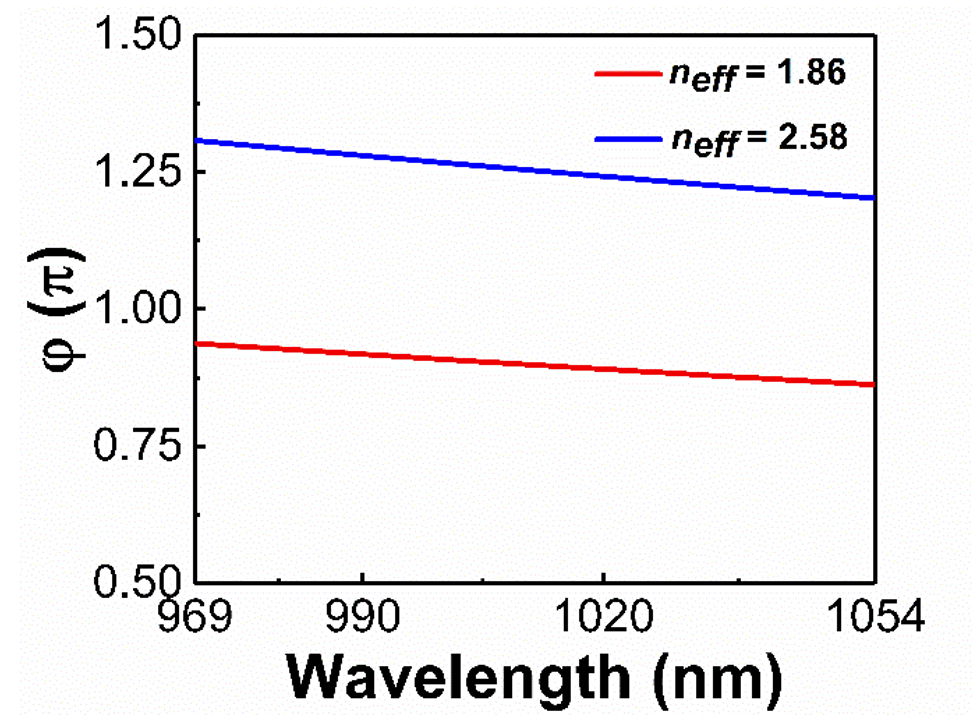
References
- Lin, M.; Xi, X.; Qiu, W.; Ai, Y.; Wang, Q.; Liu, Q.; Ouyang, Z. Star-type polarizer with equal-power splitting function for each polarization based on polarization-dependent defects in two-dimensional photonic-crystal waveguides. Opt. Express 2016, 24, 23917–23924. [Google Scholar] [CrossRef] [PubMed]
- Ordouie, E.; Alisafaee, H.; Siahmakoun, A. Ultracompact polarizing beam splitter based on single-material birefringent photonic crystal. Opt. Lett. 2018, 43, 4288–4291. [Google Scholar] [CrossRef] [PubMed]
- Feng, J.; Zhou, Z. Polarization beam splitter using a binary blazed grating coupler. Opt. Lett. 2007, 32, 1662–1664. [Google Scholar] [CrossRef] [PubMed]
- Ma, M.L.; Park, A.H.K.; Wang, Y.; Shoman, H.; Zhang, F.; Jaeger, N.A.F.; Chrostowski, L. Sub-wavelength grating-assisted polarization splitter-rotators for silicon-on-insulator platforms. Opt. Express 2019, 27, 17581–17591. [Google Scholar] [CrossRef]
- Fukuda, H.; Yamada, K.; Tsuchizawa, T.; Watanabe, T.; Shinojima, H.; Itabashi, S.-I. Ultrasmall polarization splitter based on silicon wire waveguides. Opt. Express 2006, 14, 12401–12408. [Google Scholar] [CrossRef]
- Guan, X.; Wu, H.; Shi, Y.; Dai, D. Extremely small polarization beam splitter based on a multimode interference coupler with a silicon hybrid plasmonic waveguide. Opt. Lett. 2014, 39, 259–262. [Google Scholar] [CrossRef]
- Farmahini-Farahani, M.; Mosallaei, H. Birefringent reflectarray metasurface for beam engineering in infrared. Opt. Lett. 2013, 38, 462–464. [Google Scholar] [CrossRef]
- Belosludtsev, A.; Valavicius, A.; Kyzas, N.; Kicas, S. Metal-dielectric broad-angle non-polarizing beam splitters with ultrathin copper layer. Opt. Laser Technol. 2018, 107, 335–347. [Google Scholar] [CrossRef]
- Khorasaninejad, M.; Zhu, W.; Crozier, K.B. Efficient polarization beam splitter pixels based on a dielectric metasurface. Optica 2015, 2, 376–382. [Google Scholar] [CrossRef]
- Yoon, G.; Lee, D.; Nam, K.T.; Rho, J. Geometric metasurface enabling polarization independent beam splitting. Sci. Rep. 2018, 8, 1–8. [Google Scholar] [CrossRef]
- Yu, N.F.; Genevet, P.; Kats, M.A.; Aieta, F.; Tetienne, J.P.; Capasso, F.; Gaburro, Z. Light Propagation with Phase Discontinuities: Generalized Laws of Reflection and Refraction. Science 2011, 334, 333–337. [Google Scholar] [CrossRef]
- Arbabi, A.; Horie, Y.; Bagheri, M.; Faraon, A. Dielectric metasurfaces for complete control of phase and polarization with subwavelength spatial resolution and high transmission. Nat. Nanotechnol. 2015, 10, 937–943. [Google Scholar] [CrossRef]
- Hu, X.; Wei, X. Metallic metasurface for high efficiency optical phase control in transmission mode. Opt. Express 2017, 25, 15208–15215. [Google Scholar] [CrossRef]
- Zhou, Z.P.; Li, J.T.; Su, R.B.; Yao, B.M.; Fang, H.L.; Li, K.Z.; Zhou, L.D.; Liu, J.; Stellinga, D.; Reardon, C.P.; et al. Efficient Silicon Metasurfaces for Visible Light. ACS Photonics 2017, 4, 544–551. [Google Scholar] [CrossRef]
- Mahmood, N.; Kim, I.; Mehmood, M.Q.; Jeong, H.; Akbar, A.; Lee, D.; Saleem, M.; Zubair, M.; Anwar, M.S.; Tahir, F.A.; et al. Polarisation insensitive multifunctional metasurfaces based on all-dielectric nanowaveguides. Nanoscale 2018, 10, 18323–18330. [Google Scholar] [CrossRef]
- Zhu, W.R.; Xiao, F.J.; Kang, M.; Premaratne, M. Coherent perfect absorption in an all-dielectric metasurface. Appl. Phys. Lett. 2016, 108, 121901. [Google Scholar] [CrossRef]
- Ahmadivand, A.; Gerislioglu, B.; Ahuja, R.; Mishra, Y.K. Toroidal Metaphotonics and Metadevices. Laser Photonics Rev. 2020, 14, 1900326. [Google Scholar] [CrossRef]
- Gerislioglu, B.; Bakan, G.; Ahuja, R.; Adam, J.; Mishra, Y.K.; Ahmadivand, A. The role of Ge2Sb2Te5 in enhancing the per-formance of functional plasmonic devices. Mater. Today Phys. 2020, 12, 100178. [Google Scholar] [CrossRef]
- Dong, J.; Ding, C.; Mo, J. A Low-Profile Wideband Linear-to-Circular Polarization Conversion Slot Antenna Using Metasurface. Materials 2020, 13, 1164. [Google Scholar] [CrossRef]
- Yang, Y.; Wang, W.; Moitra, P.; Kravchenko, I.I.; Briggs, D.P.; Valentine, J. Dielectric Meta-Reflectarray for Broadband Linear Polarization Conversion and Optical Vortex Generation. Nano Lett. 2014, 14, 1394–1399. [Google Scholar] [CrossRef]
- Ding, F.; Wang, Z.X.; He, S.L.; Shalaev, V.M.; Kildishev, A.V. Broadband high-efficiency half-wave plate: A super-cell-based plasmonic metasurface approach. ACS Nano 2015, 9, 4111–4119. [Google Scholar] [CrossRef] [PubMed]
- Ozer, A.; Yilmaz, N.; Kocer, H.; Kurt, H. Polarization-insensitive beam splitters using all-dielectric phase gradient metasurfaces at visible wavelengths. Opt. Lett. 2018, 43, 4350–4353. [Google Scholar] [CrossRef] [PubMed]
- Zhang, X.; Deng, R.; Yang, F.; Jiang, C.; Xu, S.; Li, M. Metasurface-Based Ultrathin Beam Splitter with Variable Split Angle and Power Distribution. ACS Photonics 2018, 5, 2997–3002. [Google Scholar] [CrossRef]
- Zhang, D.; Ren, M.; Wu, W.; Gao, N.; Yu, X.; Cai, W.; Zhang, X.; Xu, J. Nanoscale beam splitters based on gradient metasurfaces. Opt. Lett. 2018, 43, 267–270. [Google Scholar] [CrossRef]
- Wei, M.; Xu, Q.; Wang, Q.; Zhang, X.; Li, Y.; Gu, J.; Tian, Z.; Zhang, X.; Han, J.; Zhang, W. Broadband non-polarizing terahertz beam splitters with variable split ratio. Appl. Phys. Lett. 2017, 111, 071101. [Google Scholar] [CrossRef]
- Li, J.; Ye, H.; Wu, T.; Liu, Y.; Yu, Z.; Wang, Y.; Sun, Y.; Yu, L. Ultra-broadband, large-angle beam splitter based on a homogeneous metasurface at visible wavelengths. Opt. Express 2020, 28, 32226–32238. [Google Scholar] [CrossRef]
- Palik, E.D. Handbook of Optical Constants of Solids; Academic Press: Cambridge, MA, USA, 1985; pp. 547–571. [Google Scholar]
- Yang, L.; Wu, D.; Liu, Y.; Liu, C.; Xu, Z.; Li, H.; Yu, Z.; Yu, L.; Ye, H. High-efficiency all-dielectric transmission metasurface for linearly polarized light in the visible region. Photonics Res. 2018, 6, 517–524. [Google Scholar] [CrossRef]
- Larouche, S.; Smith, D.R. Reconciliation of generalized refraction with diffraction theory. Opt. Lett. 2012, 37, 2391–2393. [Google Scholar] [CrossRef]
- Chen, S.; Li, Z.; Zhang, Y.; Cheng, H.; Tian, J. Phase Manipulation of Electromagnetic Waves with Metasurfaces and Its Applications in Nanophotonics. Adv. Opt. Mater. 2018, 6. [Google Scholar] [CrossRef]

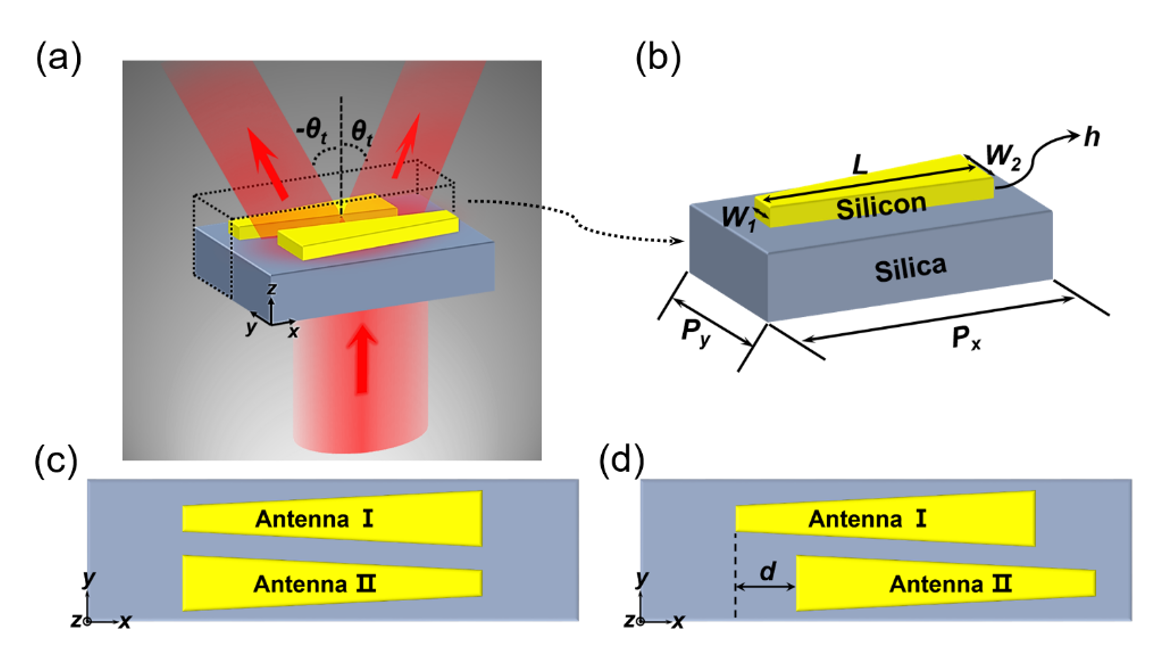
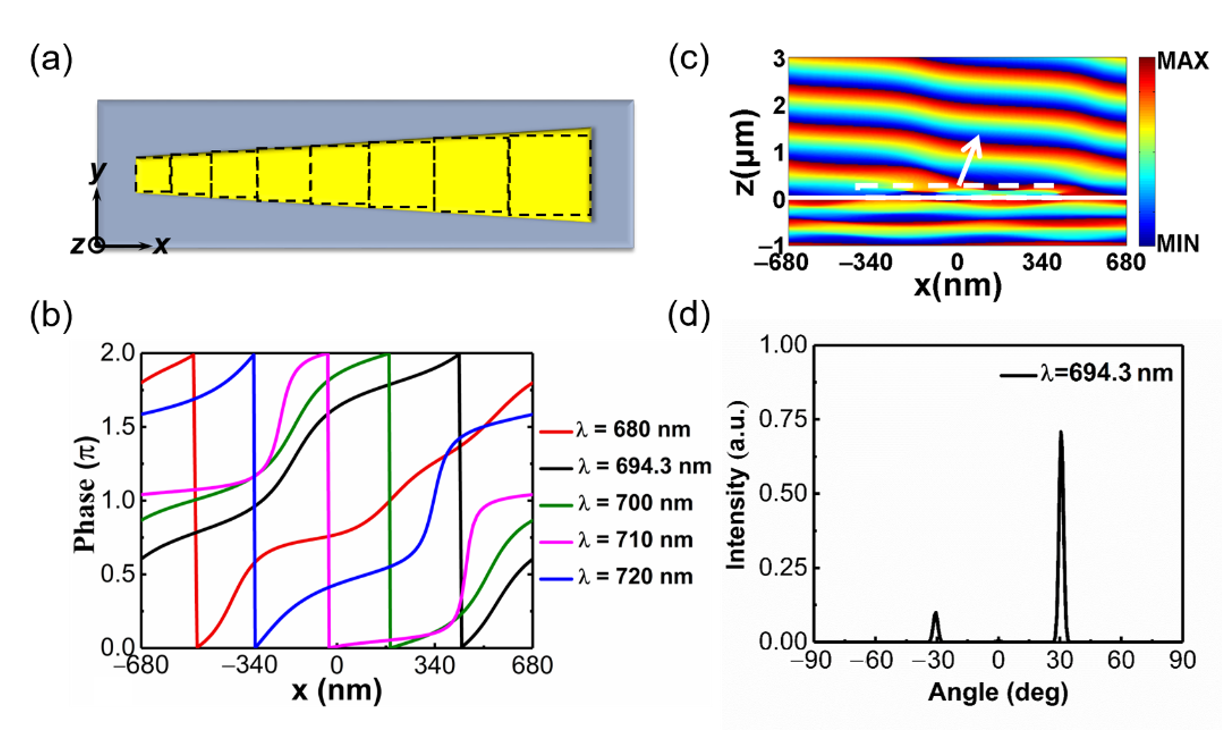

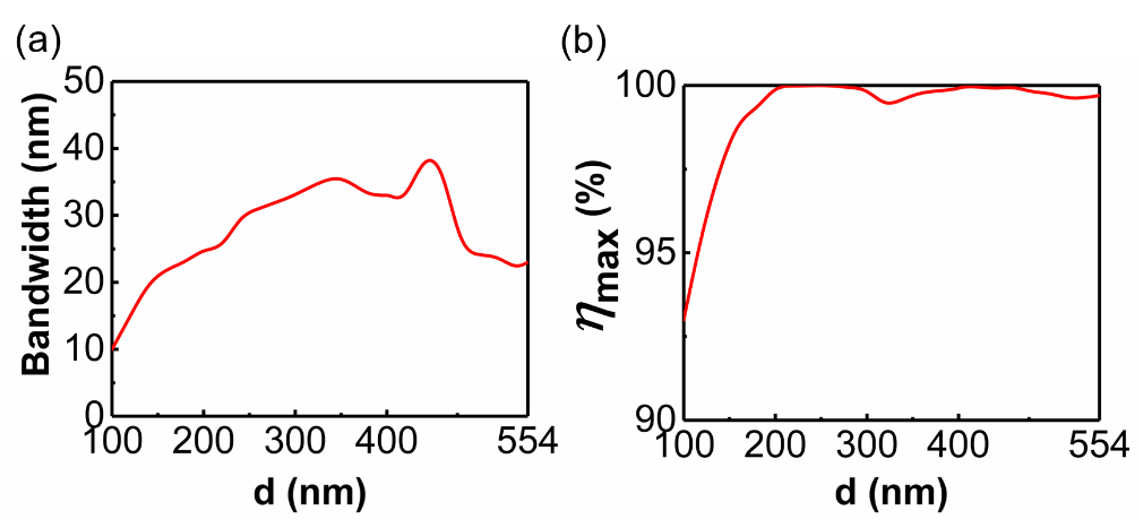
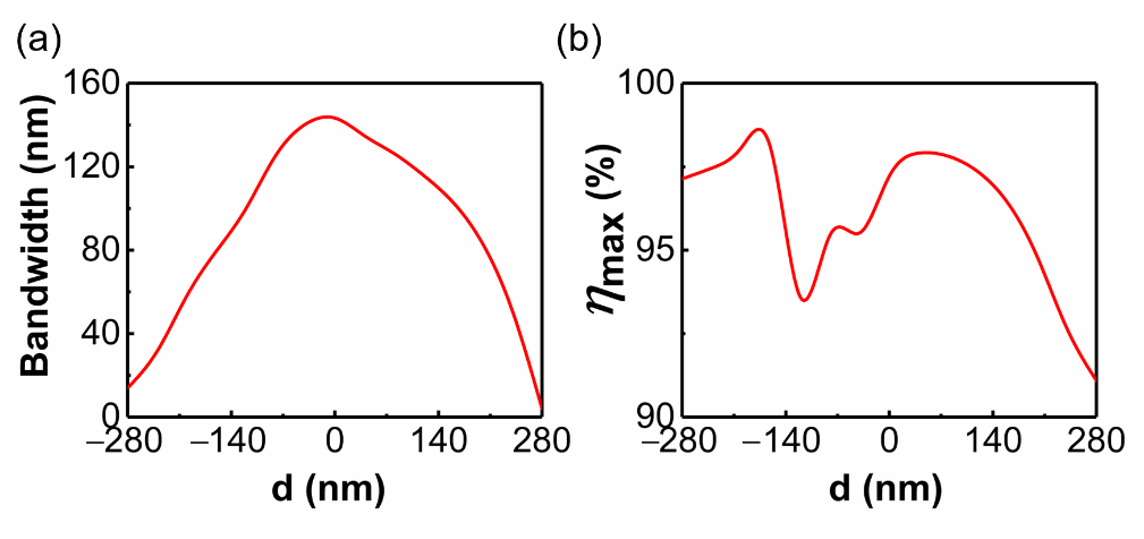
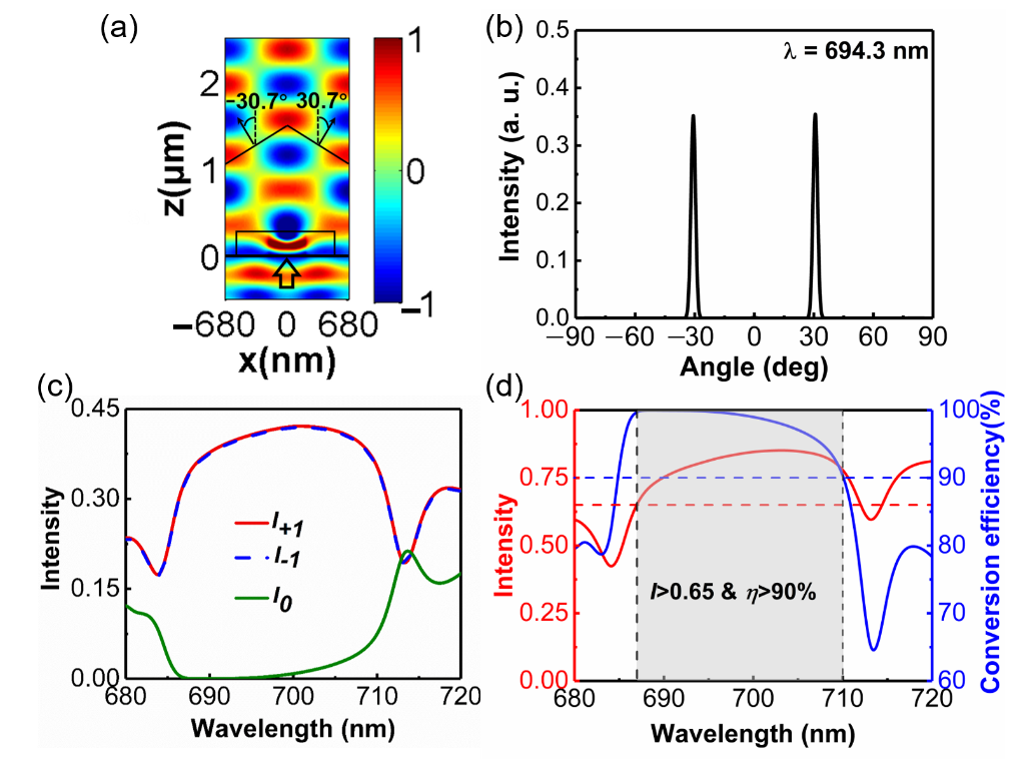


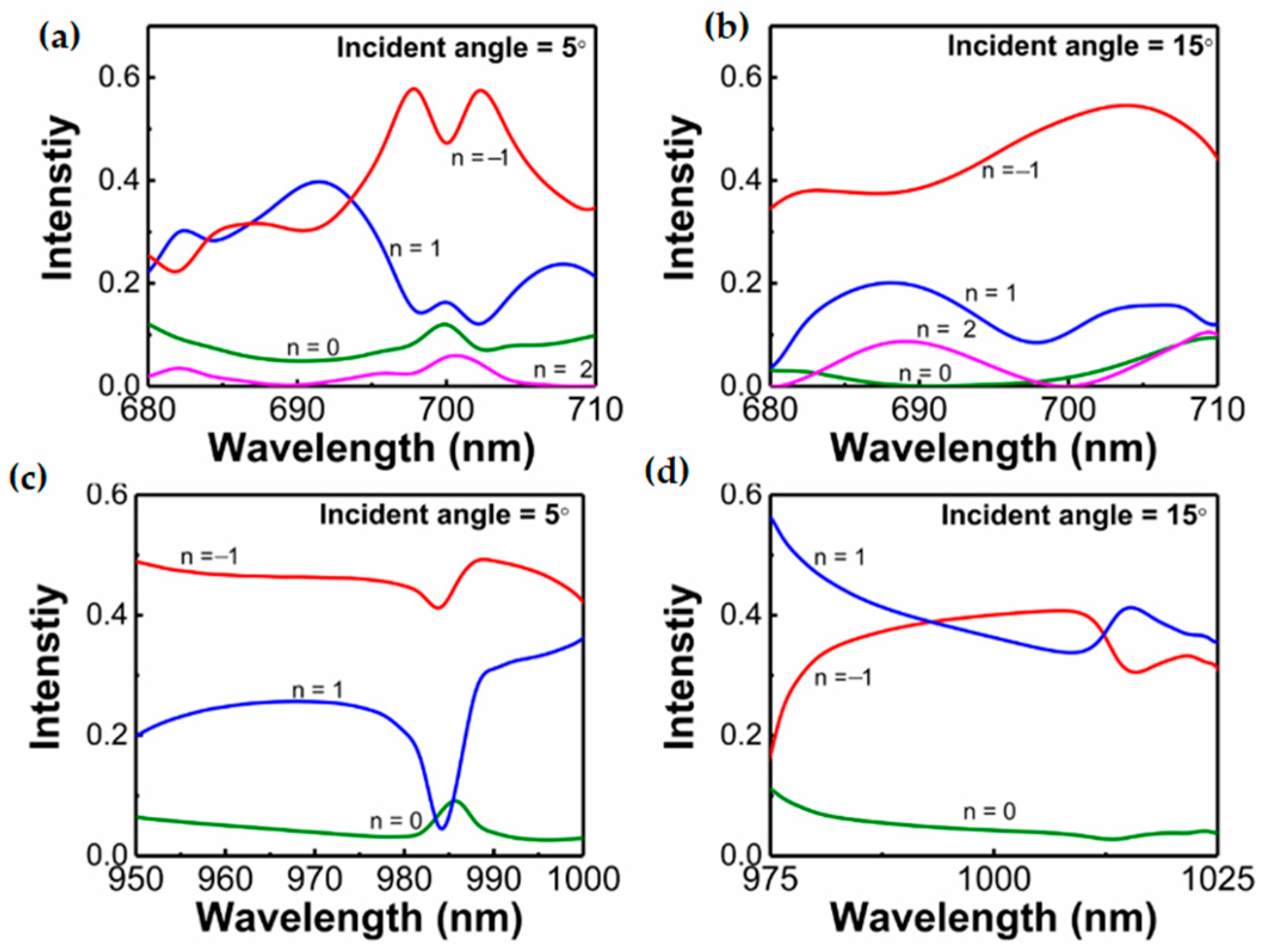
| Splitter | Material | Wavelength | Conversion Efficiency | Transmission | Propagation Angle |
|---|---|---|---|---|---|
| Ozer et al. [22] | TiO2 | 532 nm | 92% | 0.9 | ±46.8° |
| Zhang et al. [24] | lithium niobate | 800 nm | - | <0.6 | ±12.17° |
| Our paper | silicon | 996 nm (x-pol.) | 95% | 0.818 | ±47.1° |
| 694.3 nm (y-pol.) | ≈100% | 0.803 | ±30.7° |
Publisher’s Note: MDPI stays neutral with regard to jurisdictional claims in published maps and institutional affiliations. |
© 2021 by the authors. Licensee MDPI, Basel, Switzerland. This article is an open access article distributed under the terms and conditions of the Creative Commons Attribution (CC BY) license (https://creativecommons.org/licenses/by/4.0/).
Share and Cite
Li, J.; He, Y.; Ye, H.; Wu, T.; Liu, Y.; He, X.; Li, J.; Cheng, J. High-Efficiency, Dual-Band Beam Splitter Based on an All-Dielectric Quasi-Continuous Metasurface. Materials 2021, 14, 3184. https://doi.org/10.3390/ma14123184
Li J, He Y, Ye H, Wu T, Liu Y, He X, Li J, Cheng J. High-Efficiency, Dual-Band Beam Splitter Based on an All-Dielectric Quasi-Continuous Metasurface. Materials. 2021; 14(12):3184. https://doi.org/10.3390/ma14123184
Chicago/Turabian StyleLi, Jing, Yonggang He, Han Ye, Tiesheng Wu, Yumin Liu, Xuyi He, Jing Li, and Jie Cheng. 2021. "High-Efficiency, Dual-Band Beam Splitter Based on an All-Dielectric Quasi-Continuous Metasurface" Materials 14, no. 12: 3184. https://doi.org/10.3390/ma14123184
APA StyleLi, J., He, Y., Ye, H., Wu, T., Liu, Y., He, X., Li, J., & Cheng, J. (2021). High-Efficiency, Dual-Band Beam Splitter Based on an All-Dielectric Quasi-Continuous Metasurface. Materials, 14(12), 3184. https://doi.org/10.3390/ma14123184





